

Congress has an opportunity to increase MIECHV funding to expand the program's reach and reduce maternal mortality and morbidity
Home visiting in your state.
MIECHV supports voluntary, evidence-based home visiting models for children and families living in poverty across the United States.
Success Stories
Funding for home visits in a time of national crisis.
Click here for our Covid-19 Statement
What is Home Visiting?
MIECHV-supported home visiting strengthens families and communities.
What Is MIECHV?
A cornerstone of evidence-based public policy with bipartisan support.
Share Your Story
MIECHV-supported home visiting programs empower families to provide for their future. Tells us your home visiting story.
Take Action
Find out what Congress can do to expand the reach of home visiting
MIECHV-Supported Home Visiting In Your State
In FY2019, MIECHV-supported home visiting programs provided over 1,000,000 home visits to over 154,000 at-risk children and families in every U.S. state, DC, and five territories.
Click a state to view a fact sheet explaining how the MIECHV program works to improve family stability, child health and safety, and school readiness.
- American Samoa
- Northern Mariana Island
- Puerto Rico
- Virgin Islands
- Washington, DC

Tap a state to view a fact sheet explaining how the MIECHV program works to improve family stability, child health and safety, and school readiness.
- Connecticut
- Massachusetts
- Mississippi
- New Hampshire
- North Carolina
- North Dakota
- Pennsylvania
- Rhode Island
- South Carolina
- South Dakota
- West Virginia
Territories and Districts
- Northern Mariana Islands
- Washington DC
The Today Show’s “Watch What Works” Features MIECHV!
Stay informed — sign up for our newsletter today.
“It’s hard work being a mom, and it’s going to be even harder to go back to school again, but that’s what I learned through the program — to follow through with your dreams to build the life you want for your family. I recommend the program to women every day where I work. It truly has made a better life for my family.”
Jennifer , Nurse Family Partnership participant
“It’s important to keep home visiting because there are young women out there like myself that have been through a ton, who have battled through struggles, and who need to learn more about their pregnancy, the rights and wrongs, as well as to have someone there that understands them and doesn’t judge and is there through every step of the way.”
Rachel , Healthy Families America participant
National Home Visiting Resource Center
Helping children and families thrive.
- Share a Story
Home Visiting's Reach
Early childhood home visiting helps families meet children’s needs during the critical first 5 years of development. The newly released 2022 Home Visiting Yearbook explores home visiting at the national and state levels.
~17.3 million
pregnant women and families could benefit from home visiting nationally

Building on Strengths: Reaching Unhoused Families With Home Visiting Parent Support Programs
Home visiting is uniquely positioned to reach unhoused families and help them meet basic needs while supporting strong parenting skills and healthy child development. In this video, we learn how Lydia Places offers Parents as Teachers home visiting as part of a comprehensive approach to serving unhoused families.
Stay up to date on the latest home visiting information.

HomeVisit delivers integrated marketing solutions for real estate agents and brokers. With an extended menu of services spanning Fusion Photography, HomeVisit immersive 3D tour and Floor Plan renderings, HD Video Production, Aerial Imaging, Print Materials, Property Websites, Virtual Tours and Direct Mail, we provide the tools you need to market your listings in one place.
Our commitment to customers is simple: we provide the highest quality services, utilizing innovative technology, leveraged by superior service and systems. We hire the best, most experienced architectural imaging technicians and put them through an intensive, highly-detailed training protocol, to ensure that every listing we capture looks its absolute best. Our team of professionals work with you to develop and maintain a consistent professional brand that always has you looking your best so you can attract more leads, win more listings, and sell more homes. HomeVisit is powered by Urbanimmersive.
Years in business
Over $1 million
Virtual tour views
Why HomeVisit?
With over two decades of experience, millions of property website visitors, and plenty of options for any budget or home type, we’ll help you take your listings up a notch.
Ready to get started?
Sign up or log in to see what we can do for your properties.
- Terms & Conditions
Fastest Nurse Insight Engine
- MEDICAL ASSISSTANT
- Abdominal Key
- Anesthesia Key
- Basicmedical Key
- Otolaryngology & Ophthalmology
- Musculoskeletal Key
- Obstetric, Gynecology and Pediatric
- Oncology & Hematology
- Plastic Surgery & Dermatology
- Clinical Dentistry
- Radiology Key
- Thoracic Key
- Veterinary Medicine
- Gold Membership
Home Visit: Opening the Doors for Family Health
Chapter 11 Home Visit Opening the Doors for Family Health Claudia M. Smith Chapter Outline Home Visit Definition Purpose Advantages and Disadvantages Nurse–Family Relationships Principles of Nurse–Client Relationship with Family Phases of Relationships Characteristics of Relationships with Families Increasing Nurse–Family Relatedness Fostering a Caring Presence Creating Agreements for Relatedness Increasing Understanding through Communication Skills Reducing Potential Conflicts Matching the Nurse’s Expectations with Reality Clarifying Nursing Responsibilities Managing the Nurse’s Emotions Maintaining Flexibility in Response to Client Reactions Clarifying Confidentiality of Data Promoting Nurse Safety Clarifying the Nurse’s Self-Responsibility Promoting Safe Travel Handling Threats during Home Visits Protecting the Safety of Family Members Managing Time and Equipment Structuring Time Handling Emergencies Promoting Asepsis in the Home Modifying Equipment and Procedures in the Home Postvisit Activities Evaluating and Planning the Next Home Visit Consulting and Collaborating with the Team Making Referrals Legal Documentation The Future of Evidence-Based Home-Visiting Programs Focus Questions Why are home visits conducted? What are the advantages and disadvantages of home visits? How is the nurse–client relationship in a home similar to and different from nurse–client relationships in inpatient settings? How can a nurse’s family focus be maximized during a typical home visit? What promotes safety for community/public health nurses? What happens during a typical home visit? How can client participation be promoted? Key Terms Agreement Collaboration Consultation Empathy Family focus Genuineness Home visit Positive regard Presence Referral Nurses who work in all specialties and with all age groups can practice with a family focus , that is, thinking of the health of each family member and of the entire family per se and considering the effects of the interrelatedness of the family members on health. Because being family focused is a philosophy, it can be practiced in any setting. However, a family’s residence provides a special place for family-focused care. Community/public health nurses have historically sought to promote the well-being of families in the home setting ( Zerwekh, 1990 ). Community/public health nurses seek to promote health; prevent specific illnesses, injuries, and premature death; and reduce human suffering. Through home visits, community/ public health nurses provide opportunities for families to become aware of potential health problems, to receive anticipatory education, and to learn to mobilize resources for health promotion and primary prevention ( Kristjanson & Chalmers, 1991 ; Raatikainen, 1991 ). In clients’ homes, care can be personalized to a family’s coping strategies, problem-solving skills, and environmental resources (see Chapter 13 ). During home visits, community/public health nurses can uncover threats to health that are not evident when family members visit a physician’s office, health clinic, or emergency department ( Olds et al., 1995 ; Zerwekh, 1991 ). For example, during a visit in the home of a young mother, a nursing student observed a toddler playing with a paper cup full of tacks and putting them in his mouth. The student used the opportunity to discuss safety with the mother and persuaded her to keep the tacks on a high shelf. The quality of the home environment predicts the cognitive and social development of an infant ( Engelke & Engelke, 1992 ). Community/public health nurses successfully assist parents in improving relations with their children and in providing safe, stimulating physical environments. All levels of prevention can be addressed during home visits. Research has demonstrated that home visits by nurses during the prenatal and infancy periods prevent developmental and health problems ( Kitzman et al., 2000 ; Norr et al., 2003 ; Olds et al., 1986 ). Olds and colleagues demonstrated that families who received visits had fewer instances of child abuse and neglect, emergency department visits, accidents, and poisonings during the child’s first 2 years of life. These results were true for families of all socioeconomic levels but greater for low-income families. The health outcomes for families who received home visits were better than those of families that received care only in clinics or from private physicians. Furthermore, the favorable results were still apparent 15 years after the birth of the first child ( Olds et al., 1997 ), and the home visits reduced subsequent pregnancies ( Kitzman et al., 1997 ; Olds et al., 1997 ). The U.S. Advisory Board on Abuse and Neglect advocates such home-visiting programs as a means to prevent child abuse and neglect ( U.S. Department of Health and Human Services, 1990 ). Other research shows that home visits by nurses can reduce the incidence of drug-resistant tuberculosis and decrease preventable deaths among infected individuals ( Lewis & Chaisson, 1993 ). This goal is achieved through directly observing medication therapy in the individual’s home, workplace, or school on a daily basis or several times a week (see Chapter 8 ). Several factors have converged to expand opportunities for nursing care to adults and children with illnesses and disabilities in their homes. The American population has aged, chronic diseases are now the major illnesses among older persons, and attempts are being made to limit the rising hospital costs. As the average length of stay in hospitals has decreased since the early 1980s, families have had to care for more adults and children with acute illnesses in their homes. This increased demand for home health care has resulted in more agencies and nurses providing home care to the ill and teaching family members to perform the care (see Chapter 31 ). The degree to which families cope with a member with a chronic illness or disability significantly affects both the individual’s health status and the quality of life for the entire family ( Burns & Gianutsos, 1987 ; Harris, 1995 ; Whyte, 1992 ). Family members may be called on to support an individual family member’s adjustment to a chronic illness as well as take on tasks and roles that the ill member previously performed. This adjustment occurs over time and often takes place in the home. Community/public health nurses can assist families in making these adjustments. Since the late 1960s, deinstitutionalization of mentally ill clients has shifted them from inpatient psychiatric settings to their own homes, group homes, correctional facilities, and the streets (see Chapter 33 ). Nurses in the fields of community mental health and psychiatry began to include the relatives and surrogate family members in providing critical support to enable the person with a psychiatric diagnosis to live at home ( Mohit, 1996 ; Stolee et al., 1996 ). The hospice movement also recognizes the importance of a family focus during the process of a family member’s dying ( American Nurses Association [ANA], 2007a ). Care at home or in a homelike setting is cost effective under many circumstances. As the prevalence of acquired immunodeficiency syndrome (AIDS) increases and the number of older adults continues to increase, providing care in a cost-effective manner is both an ethical and an economic necessity. Nurses in any specialty can practice with a family focus. However, the specific goals and time constraints in each health care service setting affect the degree to which a family focus can be used. A home visit is one type of nurse–client encounter that facilitates a family focus. Home visiting does not guarantee a family focus. Rather, the setting itself and the structure of the encounter provide an opportunity for the nurse to practice with a family focus. A nurse visiting a client in his home listens to the man’s heart while his daughter looks on. Nurses who graduate from a baccalaureate nursing program are expected to have educational experiences that prepare them for beginning practice in community/public health nursing. Family-focused care is an essential element of community/public health nursing. One of the ways to improve the health of populations and communities is to improve the health of families ( ANA, 2007b ). Home visits may be made to any residence: apartments for older adults, group homes, boarding homes, dormitories, domiciliary care facilities, and shelters for the homeless, among others. In these residences, the family may not be related by blood, but, rather, they may be significant others: neighbors, friends, acquaintances, or paid caregivers. Nurses who are educated at the baccalaureate level are one of a few professional and service workers who are formally taught about making home visits. Some social work students, especially those interested in the fields of home health and protective services, also receive similar education. The American Red Cross and the National Home Caring Council have developed training programs for homemakers and home health aides; not all aides have received such extensive training, however. Agricultural and home economic extension workers in the United States and abroad also may make home visits ( Murray, 1968 ; World Health Organization, 1987 ). Home visit Definition A home visit is a purposeful interaction in a home (or residence) directed at promoting and maintaining the health of individuals and the family (or significant others). The service may include supporting a family during a member’s death. Just as a client’s visit to a clinic or outpatient service can be viewed as an encounter between health care professionals and the client, so can a home visit. A major distinction of a home visit is that the health care professional goes to the client rather than the client coming to the health care professional. Purpose Almost any health care service can be accomplished on a home visit. An assumption is that—except in an emergency—the client or family is sufficiently healthy to remain in the community and to manage health care after the nurse leaves the home. The foci of community/public health nursing practice in the home can be categorized under five basic goals: 1. Promoting support systems that are adequate and effective and encouraging use of health-related resources 2. Promoting adequate, effective care of a family member who has a specific problem related to illness or disability 3. Encouraging normal growth and development of family members and the family and educating the family about health promotion and illness prevention 4. Strengthening family functioning and relatedness 5. Promoting a healthful environment The five basic goals of community/public health nursing practice with families can be linked to categories of family problems ( Table 11-1 ). A pilot study to identify problems common in community/public health nursing practice settings revealed that problems clustered into four categories: (1) lifestyle and living resources, (2) current health status and deviations, (3) patterns and knowledge of health maintenance, and (4) family dynamics and structure ( Simmons, 1980 ). Home visits are one means by which community/public health nurses can address these problems and achieve goals for family health. Table 11-1 Family Health-Related Problems and Goals Problem * Goal Lifestyle and resources Promote support systems and use of health-related resources Health status deviations Promote adequate, effective family care of a member with an illness or disability Patterns and knowledge of health maintenance Encourage growth and development of family members, health promotion, and illness prevention Promote a healthful environment Family dynamics and structure Strengthen family functioning and relatedness * Problems from Simmons, D. (1980). A classification scheme for client problems in community health nursing (DHHS Pub No. HRA 8016). Hyattsville, MD: U.S. Department of Health and Human Services. Advantages and Disadvantages Advantages of home visits by nurses are numerous. Most of the disadvantages relate to expense and concerns about unpredictable environments ( Box 11-1 ). Box 11-1 Advantages and Disadvantages of Home Visiting Advantages • Home setting provides more opportunities for individualized care. • Most people prefer to receive care at home. • Environmental factors impinging on health, such as housing condition and finances, may be observed and considered more readily. • Collecting information and understanding lifestyle values are easier in family’s own environment. • Participation of family members is facilitated. • Individuals and family members may be more receptive to learning because they are less anxious in their own environments and because the immediacy of needing to know a particular fact or skill becomes more apparent. • Care to ill family members in the home can reduce overall costs by preventing hospitalizations and shortening the length of time spent in hospitals or other institutions. • A family focus is facilitated. Disadvantages • Travel time is costly. • Home visiting is less efficient for the nurse than working with groups or seeing many clients in an ambulatory site. • Distractions such as television and noisy children may be more difficult to control. • Clients may be resistant or fearful of the intimacy of home visits. • Nurse safety can be an issue. Nurse–family relationships How nurses are assigned to make home visits is both a philosophical and a management issue. Some community/public health nurses are assigned by geographical area or district . The size of the geographical area for home visits varies with the population density. In a densely populated urban area, a nurse might visit in one neighborhood; in a less densely populated area, the nurse might be assigned to visit in an entire county. With geographical assignments, the nurse has the potential to work with the entire population in a district and to handle a broad range of health concerns; the nurse can also become well acquainted with the community’s health and social resources. The potential for a family-focused approach is strengthened because the nurse’s concerns consist of all health issues identified with a specific family or group of families. The nurse remains a clinical generalist, working with people of all ages. Other community/public health nurses are assigned to work with a population aggregate in one or more geopolitical communities. For example, a nurse may work for a categorical program that addresses family planning or adolescent pregnancy, in which case the nurse would visit only families to which the category applies. This type of assignment allows a nurse to work predominantly with a specific interest area (e.g., family planning and pregnancy) or with a specific aggregate (e.g., families with fertile women). Principles of Nurse–Client Relationship with Family Regardless of whether the community/public health nurse is assigned to work with an aggregate or the entire population, several principles strengthen the clarity of purpose: • By definition, the nurse focuses on the family. • The health focus can be on the entire spectrum of health needs and all three levels of prevention. • The family retains autonomy in health-related decisions. • The nurse is a guest in the family’s home. Family Focus To relate to the family, the community/public health nurse does not have to meet all members of the household personally, although varying the times of visits might allow the nurse to meet family members usually at work or school. Relating to the family requires that the nurse be concerned about the health of each member and about each person’s contribution to the functioning of the family. One family member may be the primary informant; in such instances, the nurse should realize that the information received is being filtered by the person’s perceptions. The community/public health nurse should take the time to introduce herself or himself to each person present and address each person by name. Building trust is an essential foundation for a continued relationship ( Heaman et al., 2007 ; McNaughton, 2000 ; Zerwekh, 1992 ). The nurse should use the clients’ surnames unless they introduce themselves in another way or give permission for the nurse to be less formal. Interacting with as many family members as possible, identifying the family member most responsible for health issues, and acknowledging the family member with the most authority are important. The nurse should ask for an introduction to pets and ask for permission before picking up infants and children unless it is granted nonverbally. A nurse enters the home of a client with a young child. All Levels of Prevention Through assessment, the community/public health nurse attempts to identify what actual and potential problems or concerns exist with each individual and, thematically, within the family (see Chapter 13 ). Issues of health promotion (diet) and specific protection (immunization) may exist, as may undiagnosed medical problems for which referral is necessary for further diagnosis and treatment. Home visits also can be effective in stimulating family members to seek appropriate services such as prenatal care ( Bradley & Martin, 1994 ) and immunizations ( Norr et al., 2003 ). Actual family problems in coping with illness or disability may require direct intervention. Preventing sequelae and maximizing potential may be appropriate for families with a chronically ill member. Health-related problems may appear predominantly in one family member or among several members. A thematic family problem might be related to nutrition. For example, a mother may be anemic, a preschooler may be obese, and a father may not follow a low-fat diet for hypertension. Family Autonomy A few circumstances exist in our society in which the health of the community, or public, is considered to have priority over the right of individual persons or families to do as they wish. In most states, statutes (laws) provide that health care workers, including community/public health nurses, have a right and an obligation to intervene in cases of family abuse and neglect, potential suicide or homicide, and existence of communicable diseases that pose a threat of infection to others. Except for these three basic categories, the family retains the ultimate authority for health-related decisions and actions . In the home setting, family members participate more in their own care. Nursing care in the home is intermittent, not 24 hours a day. When the visit ends, the family takes responsibility for their own health, albeit with varying degrees of interest, commitment, knowledge, and skill. This role is often difficult for beginning community/public health nurses to accept; learning to distinguish the family’s responsibilities from the nurse’s responsibilities involves experience and consideration of laws and ethics. Except in crises, taking over for the family in areas in which they have demonstrated capability is usually inappropriate. For example, if family members typically call the pharmacy to renew medications and make their own medical appointments, beginning to do these things for them is inappropriate for the nurse. Taking over undermines self-esteem, confidence, and success. Nurse as Guest Being a guest as a community/public health nurse in a family’s home does not mean that the relationship is social. The social graces for the community and culture of the family must be considered so that the family is at ease and is not offended. However, the relationship is intended to be therapeutic. For example, many older persons believe that offering something to eat or drink is important as a sign that they are being courteous and hospitable. Because your refusal to share in a glass of iced tea may be taken as an affront, you may opt to accept the tea. However, you certainly have the right to refuse, especially if infectious disease is a concern. Validate with the client that the time of the visit is convenient. If the client fails to offer you a seat, you may ask if there is a place for you and the family to sit and talk. This place may be any room of the house or even outside in good weather. Phases of Relationships Relatedness and communication between the nurse and the client are fundamental to all nursing care. A nurse–client relationship with a family (rather than an individual) is critical to community/public health nursing. The phases of the nurse–client relationship with a family are the same as are those with an individual. Different schemes have been developed for naming phases of relationships. All schemes have (1) a preinitiation or preplanning phase, (2) an initiation or introductory phase, (3) a working phase, and (4) an ending phase (Arnold & Boggs, 2011). Some schemes distinguish a power and control or contractual phase that occurs before the working phase. The initiation phase may take several visits. During this phase, the nurse and the family get to know one another and determine how the family health problems are mutually defined. The more experience the nurse has, the more efficient she or he will become; initially, many community/public health nursing students may require four to six visits to feel comfortable and to clarify their role ( Barton & Brown, 1995 ). The nursing student should keep in mind that the relationship with the family usually involves many encounters over time—home visits, telephone calls, or visits at other ambulatory sites such as clinics. Several encounters may occur during each phase of the relationship ( Figure 11-1 ). Each encounter also has its own phases ( Figure 11-2 ). Figure 11-1 A series of encounters during a relationship. (Redrawn from Smith, C. [1980]. A series of encounters during a relationship [Unpublished manuscript]. Baltimore, MD: University of Maryland School of Nursing.) Figure 11-2 Phases of a home visit. (Redrawn from Smith, C. [1980]. Phases of a home visit [Unpublished manuscript]. Baltimore, MD: University of Maryland School of Nursing.) Preplanning each telephone call and home visit is helpful. Box 11-2 lists activities in which community/public health nurses usually engage before a home visit. The list can be used as a guide in helping novice community/public health nurses organize previsit activities efficiently. Box 11-2 Planning Before a Home Visit 1. Have name, address, and telephone number of the family, with directions and a map. 2. Have telephone number of agency by which supervisor or faculty can be reached. 3. Have emergency telephone numbers for police, fire, and emergency medical services (EMS) personnel. 4. Clarify who has referred the family to you and why. 5. Consider what is usually expected of a nurse in working with a family that has been referred for these health concerns (e.g., postpartum visit), and clarify the purposes of this home visit. 6. Consider whether any special safety precautions are required. 7. Have a plan of activities for the home visit time (see Box 11-3 ). 8. Have equipment needed for hand-washing, physical assessment, and direct care interventions, or verify that client has the equipment in the home. 9. Take any data assessment or permission forms that are needed. 10. Have information and teaching aids for health teaching, as appropriate. 11. Have information about community resources, as appropriate. 12. Have gasoline in your automobile or money for public transportation. 13. Leave an itinerary with the agency personnel or faculty. 14. Approach the visit with self-confidence and caring. The visit begins with a reintroduction and a review of the plan for the day; the nurse must assess what has happened with the family since the last encounter. At this point, the nurse may renegotiate the plan for the visit and implement it. The end of the visit consists of summarizing, preparing for the next encounter, and leave-taking. Box 11-3 describes the community/public health nurse’s typical activities during a home visit. Box 11-3 Nursing Activities During Three Phases of a Home Visit Initiation Phase of Home Visit 1. Knock on door, and stand where you can be observed if a peephole or window exists. 2. Identify self as [name], the nurse from [name of agency]. 3. Ask for the person to whom you were referred or the person with whom the appointment was made. 4. Observe environment with regard to your own safety. 5. Introduce yourself to persons who are present and acknowledge them. 6. Sit where family directs you to sit. 7. Discuss purpose of visit. On initial visits, discuss services to be provided by agency. 8. Have permission forms signed to initiate services. This activity may be done later in the home visit if more explanation of services is needed for the family to understand what is being offered. Implementation Phase of Home Visit 9. Complete health assessment database for the individual client. 10. On return visits, assess for changes since the last encounter. Explore the degree that family was able to follow up on plans from previous visit. Explore barriers if follow-up did not occur. 11. Wash hands before and after conducting any physical assessment and direct physical care. 12. Conduct physical assessment, as appropriate, and perform direct physical care. 13. Identify household members and their health needs, use of community resources, and environmental hazards. 14. Explore values, preferences, and clients’ perceptions of needs and concerns. 15. Conduct health teaching as appropriate, and provide written instructions. Include any safety recommendations. 16. Discuss any referral, collaboration, or consultation that you recommend. 17. Provide comfort and counseling, as needed. Termination Phase of Home Visit 18. Summarize accomplishments of visit. 19. Clarify family’s plan of care related to potential health emergency appropriate to health problems. 20. Discuss plan for next home visit and discuss activities to be accomplished in the interim by the community/public health nurse, individual client, and family members. 21. Leave written identification of yourself and agency, with telephone numbers. Characteristics of Relationships with Families Some differences are worth discussing in nurses’ relationships with families compared with those with individual clients in hospitals. The difference that usually seems most significant to the nurse who is learning to make home visits is the fact that the nurse has less control over the family’s environment and health-related behavior ( McNaughton, 2000 ). The relationship usually extends for a longer period. A more interdependent relationship develops between the community/public health nurse and the family throughout all steps of the nursing process. Families Retain Much Control The family can control the nurse’s entry into the home by explicitly refusing assistance, establishing the time of the visit, or deciding whether to answer the door. Unlike hospitalized clients, family members can just walk away and not be home for the visit. One study of home visits to high-risk pregnant women revealed that younger and more financially distressed women tended to miss more appointments for home visits ( Josten et al., 1995 ). Being rejected by the family is often a concern of nurses who are learning to conduct home visits. As with any relationship, anxiety can exist in relation to meeting new, unknown families. Families may actually have similar feelings about meeting the nurse and may wonder what the nurse will think of them, their lifestyle, and their health care behavior. A helpful practice is to keep your perspective; if the clients are home for your visit, they are at least ambivalent about the meeting! If they are at home to answer the door, they are willing to consider what you have to offer. Most families involved with home care of the ill have requested assistance. Because only a few circumstances exist (as previously discussed) in which nursing care can be forced on families, the nurse can view the home visit as an opportunity to explore voluntarily the possibility of engaging in relationships ( Byrd, 1995 ). The nurse is there to offer services and engage the family in a dialogue about health concerns, barriers, and goals. As with all nurse–client relationships, the nurse’s commitment, authenticity, and caring constitute the art of nursing practice that can make a difference in the lives of families. Just as not all individuals in the hospital are ready or able to use all of the suggestions made to them, families have varying degrees of openness to change. If after discussing the possibilities the family declines either overtly or through its actions, the nurse has provided an opportunity for informed decision making and has no further obligation. Goals of Nursing Care Are Long Term A second major difference in nurse relationships with families is that the goals are usually more long term than are those with individual clients in hospitals. Clients may be in hospice programs for 6 months. A family with a member who has a recent diagnosis of hypertension may take 6 weeks to adjust to medications, diet, and other lifestyle changes. A school-aged child with a diagnosis of attention deficit disorder may take as long as half the school year to show improvement in behavior and learning; sometimes, a year may be required for appropriate classroom placement. For some nurses, this time frame is judged to be slow and tedious. For others, the time frame is seen as an opportunity to know a family in more depth, share life experiences over time, and see results of modifications in nursing care. For nurses who like to know about a broad range of health and nursing issues, relationships with families stimulate this interest. Having had some experience in home visiting is helpful for nurses who work in inpatient settings; it allows them to appreciate the scope and depth of practice of community/public health nurses who make home visits as a part of their regular practice. These experiences can sensitize hospital nurses to the home environments of their clients and can result in better hospital discharge plans and referrals. Because ultimate goals may take a long time to achieve, short-term objectives must be developed to achieve long-term goals. For example, a family needs to be able to plan lower-calorie menus with sufficient nutrients before weight loss is possible; a parent may need to spend time with a child daily before unruly behavior improves. Nursing interventions in a hospital setting become short-term objectives for client learning and mastery in the home setting. In an inpatient setting, giving medications as prescribed is a nursing action. In the home, the spouse giving medications as prescribed becomes a behavioral objective for the family; the related nursing action is teaching. Human progress toward any goal does not usually occur at a steady pace. For example, you may start out bicycling faithfully three times a week and give up abruptly. Similarly, clients may skip an insulin dose or an oral contraceptive. A family may assertively call appropriate community agencies, keep appointments, and stop abruptly. Families can be committed to their own health and well-being and yet not act on their commitment consistently. Recognizing that setbacks and discouragement are a part of life allows the community/public health nurse to be more accepting of reality and have the objectivity to renegotiate goals and plans with families. Box 11-4 includes evidence-based ways to foster goal accomplishment. Box 11-4 Best Practices in Fostering Goal Accomplishment With Families 1. Share goals explicitly with family. 2. Divide goals into manageable steps. 3. Teach the family members to care for themselves. 4. Do not expect the family to do something all of the time or perfectly. 5. Be satisfied with small, subtle changes. 6. Be flexible. Changes are sometimes subtle or small. Success breeds success, at least motivationally. The short-term goals on which everyone has agreed are important to make clear so that the nurse and the family members have a common basis for evaluation. Goals can be set in a logical sequence, in small steps, to increase the chance of success. In an inpatient setting, the skilled nurse notices the subtle changes in client behavior and health status that can warn of further disequilibrium or can signal improvement. Similarly, during a series of home visits, the skilled nurse is aware of slight variations in home management, personal care, and memory that may presage a deteriorating biological or social condition. Nursing Care Is More Interdependent with Families Because families have more control over their health in their own homes and because change is usually gradual, greater emphasis must be placed on mutual goals if the nurse and family are to achieve long-term success. Except in emergency situations, the client determines the priority of issues. A parent may be adamant that obtaining food is more important than obtaining their child’s immunization. A child’s school performance may be of greater concern to a mother than is her own abnormal Papanicolaou (Pap) smear results. Failure of the nurse to address the family’s primary priority may result in the family perceiving that the nurse does not genuinely care. At times, the priority problem is not directly health related, or the solution to a health problem can be handled better by another agency or discipline. In these instances, the empathic nurse can address the family’s stress level, problem-solving ability, and support systems and make appropriate referrals. When the nurse takes time to validate and discuss the primary concern, the relationship is enhanced. Families are sometimes unaware of what they do not know. The nurse must suggest health-related topics that are appropriate for the family situation. For example, a young mother with a healthy newborn may not have thought about how to determine when her baby is ill. A spouse caring for his wife with Alzheimer disease may not know what safety precautions are necessary. Community/public health nurses seek to enhance family competence by sharing their professional knowledge with families and building on the family’s experience ( Reutter & Ford, 1997 ; SmithBattle, 2009 ). Flexibility is a key. Because visits occur over several days to months, other events (e.g., episodic illnesses, a neighbor’s death, community unemployment) can impinge on the original plan. Family members may be rehospitalized and receive totally new medical orders once they are discharged to home. The nurse’s clarity of purpose is essential in identifying and negotiating other health-related priorities after the first concerns have been addressed ( Monsen, Radosevich, Kerr, & Fulkerson, 2011 ). Increasing nurse–family relatedness What promotes a successful home visit? What aspects of the nurse’s presence promote relatedness? What structures provide direction and flexibility? The nursing process provides a general structure, and communication is a primary vehicle through which the nursing process is manifested. The foundation for both the nursing process and communication is relatedness and caring ( ANA, 2003 ; McNaughton, 2005 ; Roach, 1997 ; SmithBattle, 2009 ; Watson, 2002 ; Watson, 2005 ). Fostering a Caring Presence Nursing efforts are not always successful. However, by being concerned about the impact of home visits on the family and by asking questions regarding her or his own motivations, the nurse automatically increases the likelihood that home visits will be of benefit to the family. The nurse is acknowledging that the intention is for the relationship to be meaningful to both the nurse and the family. Building and preserving relationships is a central focus of home visiting and requires significant effort ( Heaman et al., 2007 ; McNaughton, 2000 , 2005 ). The relatedness of nurses in community health with clients is important ( Goldsborough, 1969 ; SmithBattle, 2009 ; Zerwekh, 1992 ). Involvement, essentially, is caring deeply about what is happening and what might happen to a person, then doing something with and for that person. It is reaching out and touching and hearing the inner being of another…. For a nurse–client relationship to become a moving force toward action, the nurse must go beyond obvious nursing needs and try to know the client as a person and include him in planning his nursing care. This means sharing feelings, ideas, beliefs and values with the client…. Without responsibility and commitment to oneself and others…[a person] only exists. It is through interaction and meaningful involvement with others that we move into being human ( Goldsborough, 1969 , pp. 66-68). Mayers (1973, p. 331) observed 16 randomly selected nurses during home visits to 37 families and reported that “regardless of the specific interaction style [of each nurse], the clients of nurses who were client-focused consistently tended to respond with interest, involvement and mutuality.” A client-focused nurse was observed as one who followed client cues, attempted to understand the client’s view of the situation, and included the client in generating solutions. Being related is a contribution that the nurse can make to the family, independent of specific information and technical skills, a contribution that students often underestimate. Although being related is necessary, it is inadequate in itself for high-quality nursing. A community/public health nurse must also be competent. Community/public health nursing also depends on assessment skills, judgment, teaching skills, safe technical skills, and the ability to provide accurate information. As a community/public health nurse’s practice evolves, tension always exists between being related and doing the tasks. In each situation, an opportunity exists to ask, “How can I express my caring and do (perform direct care, teach, refer) what is needed?” Barrett (1982) and Katzman and colleagues (1987) reported on the differences that students actually make in the lives of families. Barrett (1982) demonstrated that postpartum home visits by nursing students reduced costly postpartum emergency department and hospital visits. Katzman and co-workers (1987) considered hundreds of visits per semester made by 80 students in a southwestern state to families with newborns, well children, pregnant women, and members with chronic illnesses. Case examples describe how student enthusiasm and involvement contributed to specific health results. Everything a nurse has learned about relationships is important to recall and transfer to the experience of home visiting. Carl Rogers (1969) identified three characteristics of a helping relationship: positive regard, empathy, and genuineness. These characteristics are relevant in all nurse–client relationships, and they are especially important when relationships are initiated and developed in the less-structured home setting. Presence means being related interpersonally in ways that reveal positive regard, empathy, genuineness, and caring concern. How is it possible to accept a client who keeps a disorderly house or who keeps such a clean house that you feel as if you are contaminating it by being there? How is it possible to have positive feelings about an unmarried mother of three when you and your partner have successfully avoided pregnancy? Having positive regard for a family does not mean giving up your own values and behavior (see Chapter 10 ). Having positive regard for a family that lives differently from the way you do does not mean you need to ignore your past experiences. The latter is impossible. Rather, having positive regard means having the ability to distinguish between the person and her or his behavior. Saying to yourself, “This is a person who keeps a messy house” is different from saying, “This person is a mess!” Positive regard involves recognizing the value of persons because they are human beings. Accept the family, not necessarily the family’s behavior. All behavior is purposeful; and without further information, you cannot determine the meaning of a particular family behavior. Positive regard involves looking for the common human experiences. For example, it is likely that both you and client family members experience awe in the behavior of a newborn and sadness in the face of loss. Empathy is the ability to put yourself in someone else’s shoes and to be able to walk in her or his footsteps so as to understand her or his journey. “Empathy requires sensitivity to another’s experience…including sensing, understanding, and sharing the feelings and needs of the other person, seeing things from the other’s perspective” according to Rogers (cited in Gary & Kavanagh, 1991 , p. 89). Empathy goes beyond self and identity to acknowledge the essence of all persons. It links a characteristic of a helping relationship with spirituality or “a sense of connection to life itself” ( Haber et al., 1987 , p. 78). Empathy is a necessary pathway for our relatedness. However, what does understanding another person’s experience mean? More than emotions are involved. A person’s experience includes the sense that she or he makes of aspects of human existence ( SmithBattle, 2009 ; van Manen, 1990 ). Being understood means that a person is no longer alone ( Arnold, 1996 ). Being understood provides support in the face of stress, illness, disability, pain, grief, and suffering. When a client feels understood in a nurse–client partnership (side-by-side relationship), the client’s experience of being cared for is enhanced ( Beck, 1992 ). To understand another person’s experience, you must be able to imagine being in her or his place, recognize commonalities among persons, and have a secure sense of yourself ( Davis, 1990 ). Being aware of your own values and boundaries is helpful in retaining your identity in your interactions with others. To understand another individual’s experience, you must also be willing to engage in conversation to negotiate mutual definitions of the situation. For example, if you are excited that an older person is recovering function after a stroke, but the person’s spouse sees only the loss of an active travel companion, a mutual definition of the situation does not exist. Empathy will not occur unless you can also understand the spouse’s perspective. As human beings, we all like to perceive that we have some control in our environment, that we have some choice. We avoid being dominated and conned. The nurse’s genuineness facilitates honesty and disclosure, reduces the likelihood that the family will feel betrayed or coerced, and enhances the relationship. Genuineness does not mean that you speak everything that you think. Genuineness means that what you say and do is consistent with your understanding of the situation. The nurse can promote genuine self-expression in others by creating an atmosphere of trust, accepting that each person has a right to self-expression, “actively seeking to understand” others, and assisting them to become aware of and understand themselves ( Goldsborough, 1969 , p. 66). When family members do not believe that being genuine with the nurse is safe, they may tell only what they think the nurse would like to hear. This action makes developing a mutual plan of care much more difficult. The reciprocal side of genuineness is being willing to undertake a journey of self-expression, self-understanding, and growth. Tamara, a recent nursing graduate, wrote about her growing self-responsibility: “Although I felt out of control, I felt very responsible. I took pride in knowing that these families were my families, and I was responsible for their care. I was responsible for their health teaching. This was the first semester where there was no a faculty member around all day long. I feel that this will help me so much as I begin my nursing career. I have truly felt independent and completely responsible for my actions in this clinical experience.” This student, who preferred predictable environments, was able to confront her anxiety and anger in environments in which much was beyond her control. A mother was not interested in the student’s priorities. A family abruptly moved out of the state in the middle of the semester. Nonetheless, the student was able to respond in such circumstances. She became more responsible, and she was able to temper her judgment and work with the mother’s concern. When the family moved, the student experienced frustration and anger that she would not see the “fruits of her labor” and that she would “have to start over” with another family. However, her ability to respond increased because of her commitment to her own growth, relatedness with families, and desire to contribute to the health and well-being of others. In a context of relating with and advocating for the family, the relationship becomes an opportunity for growth in both the nurse’s and the family’s lives ( Glugover, 1987 ). Imagine standing side-by-side with the family, being concerned for their well-being and growth. Now imagine talking to a family face-to-face, attempting to have them do things your way. The first image is a more caring and empathic one. Creating Agreements for Relatedness How can communications be structured to increase the participation of family members? Without the family’s engagement, the community/public health nurse will have few positive effects on the health behavior and health status of the family and its members. Nurses are expert in caring for the ill; in knowing about ways to cope with illness, to promote health, and to protect against specific diseases; and in teaching and supporting family members. Family members are experts in their own health. They know the family health history, they experience their health states, and they are aware of their health-related concerns. Through the nurse–family relationship, a fluid process takes place of matching the family’s perceived needs with the nurse’s perceptions and professional judgments about the family’s needs. Paradoxically, the more skilled the nurse is in forgetting her or his own anxiety about being the good nurse, the more likely the nurse is to listen to the family members, validate their reality, and negotiate an adequate, effective plan of care. One study of home visits revealed that more than half of the goals stated by public health nurses to the researcher could not be detected, even implicitly, during observations of the home visits. Therefore, half the goals were known only to the nurse and were, therefore, not mutual. The more specifically and concretely the goals were stated by the nurse to the researcher, the greater would be the likelihood that the clients understood the nurse’s purposes ( Mayers, 1973 ). To negotiate mutual goals, the client needs to understand the nurse’s purposes. The initial letter, telephone call, or home visit is the time to share your ideas with the family about why you are contacting them. During the first interpersonal encounter by telephone or home visit, explore the family members’ ideas about the purpose of your visits. This phase is essential in establishing a mutually agreed on basis for a series of encounters. As a result of her qualitative research study of maternal-child home visiting, Byrd (2006, p. 271) stated that “people enter…relationships with the expectation of receiving a benefit” that may be information, status, service, or goods. Byrd asserted that it is important for nurses to create client expectations through previsit publicity about (marketing) home-visiting programs. Also it is essential to understand the expectations of the specific persons being visited. Family members may have had previous relationships with community/public health nurses and students. Family members may be able to share such information as what they found to be most helpful, why they are willing to work with a nurse or student again, and what goals they have in mind. Other families who have had no prior experience with community/public health nurses may not have specific expectations. Asking is important. A contract is a specific, structured agreement regarding the process and conditions by which a health-related goal will be sought. In the beginning of most student learning experiences, the agreement usually entails one or more family members continuing to meet with the nursing student for a specific number of visits or weeks. Initially, specific goals and the nurse’s role regarding health promotion and illness prevention may be unclear. (If this role was already clear, undergoing a period of study and orientation would be unnecessary.) Initially, the agreement may be as simple as, “We will meet here at your house next Tuesday at 11:00 AM until around noon to continue to discuss what I can offer related to your family’s health and what you’d like. We can get to know each other better. We can talk more about how the week has gone for you and your family with your new baby.” These statements are the nurse’s oral offer to meet under specific conditions of time and place. The process of mutual discussion is mentioned. The goals remain general and implicit: fostering the family’s developmental task of incorporating an infant and fostering family–nurse relatedness. For the next week’s contract to be complete, the family member or members would have to agree. The most important element initially is whether agreement about being present at a specific time and place can be reached. If 11:00 AM is not workable for the family, would another time during the day when you both are available be mutually agreeable? For families who do not focus as much on the future, a community/public health nurse needs to be more flexible in scheduling the time of each visit. The word contract often implies legally binding agreements. This is not true of nurse–client contracts. Nurses are legally and ethically bound to keep their word in relation to nursing care; clients are not legally bound to keep their agreements. However, establishing a mutual agreement for relating increases the clarity of who will do what, when, where, for what purposes, and under what conditions. Because of some people’s negative response to the word contract, agreement or discussion of responsibilities may be better. An agreement may be oral or written. For some families, written agreements, especially early in the relationship, may be perceived as a threat. For example, a family that has been conned by a household repair scheme may be very suspicious of written agreements. Family members who are not legal citizens may not want to sign an agreement for fear that if it is not kept they will be punished. Do not push for a written agreement if the family is uncomfortable. If you do notice such discomfort, this may be a good opportunity to explore their fears. Written agreements are required when insurance is paying for the care provided by nurses working with home health agencies and to comply with the Health Insurance Portability and Accountability Act (HIPAA). Helgeson and Berg (1985) describe factors affecting the contracting process by studying a small convenience sample of 15 community/public health nursing students and 12 client responses. Of the 11 students who introduced the idea of a contract to clients, all did so between the second and the fourth visits of a 16-week series of visits; 9 students did so orally rather than in writing. No specific time was the best. Eight clients were very receptive to the idea because they liked the idea of establishing goals to work toward and felt the contract would serve as a reminder of their responsibility. The very process of developing a draft agreement to present to families provides the novice practitioner with an increased focus of care, clarity of nurse and family responsibilities and activities, and a basis from which to negotiate modifications in client behaviors ( Helgeson & Berg, 1985 ; Sheridan & Smith, 1975 ). The Home Visiting Evaluation Tool in Figure 11-3 lists nurse behaviors that are appropriate for home visits, especially initial home visits and those early in a series of home visits. Nurses can use this list as a preplanning tool to identify their readiness to conduct a specific home visit. Additionally, students and community/public health nurses have used the tool to evaluate initial home visits and identify their behaviors that were omitted and needed to be included on the second home visits. The tool also has been used jointly as an evaluation tool by nurses and supervisors and students and faculty. Figure 11-3 Home Visiting Evaluation Tool. (From Chichester, M., & Smith, C. [1980]. Home visiting evaluation tool [Unpublished manuscript]. Baltimore, MD: University of Maryland School of Nursing.)
Share this:
- Click to share on Twitter (Opens in new window)
- Click to share on Facebook (Opens in new window)
Related posts:
- Home Health Care
- Health Promotion and Risk Reduction in the Community
- Disaster Management: Caring for Communities in an Emergency
- Financing of Health Care: Context for Community/Public Health Nursing
Stay updated, free articles. Join our Telegram channel
Comments are closed for this page.

Full access? Get Clinical Tree

- Cast & crew
- User reviews
Yeh Rishta Kya Kehlata Hai

Akshara and Naitik, who were married in an arranged marriage, gradually fall in love and together they face all the problems of their family. Not only this, the stories of his children have ... Read all Akshara and Naitik, who were married in an arranged marriage, gradually fall in love and together they face all the problems of their family. Not only this, the stories of his children have also been depicted. Akshara and Naitik, who were married in an arranged marriage, gradually fall in love and together they face all the problems of their family. Not only this, the stories of his children have also been depicted.
- Karan Mehra
- Ayush Agarwal
- 113 User reviews
- 2 Critic reviews
- 79 wins & 83 nominations
Episodes 4282

- Akshara Naitik Singhania …
- Naitik Singhania

- Naira Kartik Goenka …

- Kartik Goenka

- Rajshri Maheshwari …

- Vishambharnath Maheshwari
- Varsha Maheshwari …
- Manish Goenka

- Rajshekhar Singhania
- Rashmi Singhani …

- Devyani Rajshekhar Singhania …

- Suhasini Kamal Goenka

- Swarna Manish Goenka

- Akhilesh Goenka
- Surekha Akhilesh Goenka
- Keerti Naksh Singhania …
- All cast & crew
- Production, box office & more at IMDbPro
More like this

Did you know
- Trivia This is the longest running hindi television series in term of episodes. On 11th September 2019, it became first show to cross the 3000 episodes.
- Connections Featured in Varisu (2023)
User reviews 113
- hchhabra-22167
- Nov 1, 2018
- How many seasons does Yeh Rishta Kya Kehlata Hai have? Powered by Alexa
- January 12, 2009 (India)
- Official Streaming Page
- Tình Yêu Diệu Kỳ
- Director's Kut Productions
- See more company credits at IMDbPro
Technical specs
- Runtime 20 minutes
Related news
Contribute to this page.

- See more gaps
- Learn more about contributing
More to explore
Recently viewed.
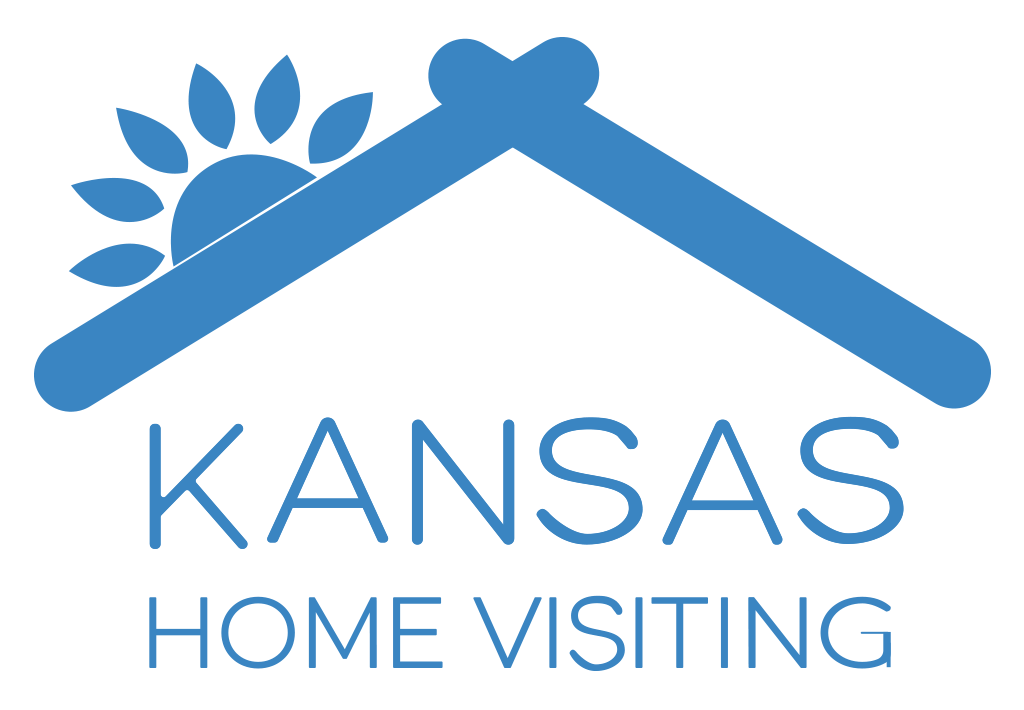
- About Kansas Home Visiting
- Why Support Is Important
- About MIECHV
- Find a Program
- Explore Resources
- Resources for Visitors
- What is MCH Home Visiting?
- Kansas Home Visiting Needs Assessment
- 2023 Kansas Home Visiting Conference
Steps for Conducting a Home Visit

Establishing Trust and Connection
Meeting the family on its home ground may contribute to their sense of control and active participation in planning and achieving health goals.
Phases/Activities of a Home Visit
Initiation Phase
- Identify source of referral for visit
- Clarify purpose for home visit
- Share information on reason and purpose of visit with family
Pre-Visit Phase
- Initiate contact with mother/family
- Establish shared perception of purpose with mother/family
- Determine mother/family’s willingness for home visit
- Schedule home visit
- Review referral and/or family record
In-Home Phase
- Introduction of self and identity
- Social interaction to establish rapport
- Establish relationship
- Implement educational materials and/or make referrals
- Review visit with family
- Plan for future visits as needed
Post-Visit Phase
- Record visit and plan for next visit
- Follow-up with educational materials and/or referrals
- Share full article
Advertisement
Supported by
Nancy Pelosi Meets With Dalai Lama, Despite China’s Criticism
The former House speaker joined a congressional delegation that met with the Tibetan spiritual leader at his home in India. China calls him a separatist.

By Mujib Mashal and Hari Kumar
Reporting from New Delhi
A high-level U.S. congressional delegation, including the former House speaker Nancy Pelosi, met with the Dalai Lama at his Indian home on Wednesday, a visit that was condemned in advance by China’s government, which considers the exiled Tibetan spiritual leader a separatist.
The delegation, led by Michael McCaul, the Republican chairman of the House Committee on Foreign Affairs, arrived on Tuesday in the Himalayan town of Dharamsala, where the Dalai Lama has lived since the 1960s. The delegation visited the offices of the Tibetan government in exile, which is pushing for autonomy for Tibet within China.
The trip comes days after Congress passed a bill with bipartisan support that urged China to start dialogue with Tibetan leaders to find a solution to the longstanding conflict.
China’s criticism of the visit was immediate and unsurprising. Its leaders consider the government in exile illegal and regard any support for the cause of autonomy for Tibet, which they call Xizang, as interference in internal Chinese matters.
“We urge the U.S. side to fully recognize the anti-China separatist nature of the Dalai group, honor the commitments the U.S. has made to China on issues related to Xizang, stop sending the wrong signal to the world,” the Chinese Embassy in New Delhi said in a statement on Tuesday night.
At a public function on Wednesday after the meeting with the Dalai Lama, Mr. McCaul said Chinese officials had sent the delegation a letter “warning us not to come here.” He said the United States stood with Tibet in what he called its right to self-determination. “America, the beautiful, will support Tibet to remain a powerful force as always,” he said.
U.S. officials have often met with the Dalai Lama, 88. Ms. Pelosi’s presence in the delegation, however, brought reminders of her 2022 trip to Taiwan , the self-governing island that China claims as its territory, when she was still speaker of the House.
That contentious visit, which raised fears within the Biden administration of further deteriorating an already frosty relationship with Beijing, led to a sharp response from China, including trade restrictions on Taiwan and military exercises near the island.
The visit to India also comes as Washington and New Delhi deepen their relationship, motivated in part by the perception of a shared Chinese threat. Jake Sullivan, President Biden’s national security adviser, is in New Delhi this week, holding multiple rounds of talks with Indian officials on expanding defense and technology cooperation.
Those extensive discussions, coming weeks after Prime Minister Narendra Modi won a third term in office, indicate how much Washington prioritizes the relationship with India, with American officials increasingly speaking of New Delhi as a counterweight to Beijing.
Tenzin Lekshay, a spokesman for the Central Tibetan Administration, the government in exile, said that Tibet’s situation should not be seen through “the lens of increasing rivalry between the U.S. and China,” but as a reminder of how the Tibetan way of life “is facing an existential threat” as China assimilates the region.
“We do hope that leaders of the free world will stand for the Tibet cause, particularly stressing the Chinese leadership to reinstall the dialogue to resolve the Sino-Tibet conflict,” Mr. Lekshay said.
Mujib Mashal is the South Asia bureau chief for The Times, helping to lead coverage of India and the diverse region around it, including Bangladesh, Sri Lanka, Nepal and Bhutan. More about Mujib Mashal
Hari Kumar covers India, based out of New Delhi. He has been a journalist for more than two decades. More about Hari Kumar

Khatu Shyamji- How to Reach & Best Time to Visit
Khatu Shyamji is worshipped in the same form as Lord Krishna since the two are interchangeable. In Hinduism, Barbarika, the son of Ghatotkacha, is represented by KhatuShyam. The Mahabharata is where the legend starts. The courageous prince Bhima, the second of the Pandava brothers, was the great-grandfather of Barbarika, also known as Khatu Shyamji or Shyam Baba. He was the progeny of Bhima through Jagadamba, one of Bhima’s wives, and Ghatotkacha. Barbarika showed incredible bravery as a fighter even as a young child. His mother taught him the fundamentals of combat. Shiva, pleased with his abilities, gave him three arrows that could never fail. Later, the god of fire Agni gave him the bow that would enable him to triumph across the three realms.
Who is Barbarik or Khatu Shyam?
Bhim, the second Pandav of the Mahabharata, had a grandson named Barbarik. His parents are Maurvi and Ghatotkach. The tribal princess Hidimba and Bhim’s son Ghatotkach.
a legend Barbarik was a valiant fighter. He had a special triple arrow, which is a bow that shoots three arrows. Any fight may be over with the three arrows in under a minute. The first arrow would designate the targets that need protection. The second arrow would mark the targets for the third arrow, which would then go and kill the targets.
Other beautiful places to visit in RAJASTHAN :
- Mount Abu| Best places to visit | Things to Do | How to Reac h
- Amber / Amer Fort Jaipur, India
- Ranthambore National Park | Ranthambore Safari Booking | How to reach, Best Time to Visit
KHATU SHYAM MANDIR, RAJASTHAN
One of the most famous tourist spots in Rajasthan is the Khatu Shyam Ji Mandir, which is located in the Sikar district. Hindu mythology holds that Khatu Shyam Ji is a manifestation of Barbarika, the son of Ghatotkacha. If done with genuine piety, it is stated that devotees who utter his name with all of their hearts are blessed and have their problems vanquished.
Khatu Shyam Ji Darshan Booking Online Registration Portal 2022
Website for Registration and Online Booking for Khatu Shyam Time of Khatu Shyam Ji Aarti, Phone Number: Visit the Baba Khatu Shyam Mandir if you’re a devotee waiting for Khatu Shyam Darshan (Rajasthan). The federal government has immediately revoked the order of restrictions that had been put in place because of the corona outbreak. Now, pilgrims can purchase tickets for Khatu Shyam Darshan online and travel to the Khatu Shyam Temple. The Khatu Shyam Ji Darshan Registration webpage was launched by the Shyam Mandir Committee. Devotees can reserve an online ticket for Khatu Shyam Darshan through the official website www.shrishyamdarshan.in during the designated time period.
THE STORY BEHIND KHATU SHYAM JI TEMPLE, RAJASTHAN
Hindu mythology claims that Barbarika’s might was unrivalled before the Mahabharata conflict ever started. He had made the choice to side with the weaker side in order to maintain his moral integrity; nevertheless, doing so would have resulted in the total destruction of both sides, leaving Barbarika as the lone survivor. According to legend, Shree Krishna begged Barbarika for his head (sheesh daan) in order to prevent such disastrous outcomes, and he gladly complied. Barbarika’s heroic sacrifice made Shree Krishna so delighted that he bestowed a boon on him, according to which Barbarika would be recognized in the Kaliyug (current era) by Krishna’s own name, Shyam Ji, and would be worshipped in his own form.
BUILDING THE KHATU SHYAM MANDIR IN RAJASTHAN
Shree Krishna blessed Barbarika’s skull and drowned it in the Rupawati River during the battle. The head was discovered after the kaliyug started at a place that had not been seen before. It was buried in the Rajasthani village of Khatu. A cow’s udders began to spontaneously discharge milk as she crossed the burying point. The location was uncovered by shocked locals, who then discovered the head buried there. In a dream, Roopsingh Chauhan, the former king of Khatu, was asked to place the head within a shrine. At this time, the temple was constructed and the head was placed within.
BATHING IN THE KUND NEAR KHATU SHYAM JI’S TEMPLE, RAJASTHAN
The Shyam Kund, a sacred pond, is located next to the temple. According to legend, this is where Khatu Shyam Ji’s head was retrieved. A common notion among followers is that taking a swim in this pond will heal one of their problems and restore them to good health. People taking ritual baths in the pond with devout fervor are a familiar sight. Additionally, bathing at the Shyam Kund during the annual Phalguna Mela Festival is thought to be particularly beneficial.
AT THE KHATU SHYAM MANDIR, THE AARTIS WERE PERFORMED.
At the Khatu Shyam Ji mandir, five aartis are conducted each day. If you were to arrange a visit to this lovely temple, you should try to attend one of these aartis because the atmosphere of devotion and tranquilly created by the chanting and the aarti is unmatched. When the temple opens its doors to worshippers in the morning, Mangala Aarti is performed. As the name suggests, the Shringaar Aarti occurs when Khatu Shyam Ji’s idol is lavishly decorated and performed. Bhog Aarti: At noon, when bhog or prasad is presented to the Lord, the third aarti of the day is performed. Sandhya Aarti: This aarti is offered in the late afternoon, just before sunset. Sayana Aarti: This ritual is performed just before the temple closes for the evening. At all these times, two particular hymns are chanted. The Shri Shyam Aarti and the Shri Shyam Vinati are these.
Best Time to Visit KHATU SHYAM JI Temple IN RAJASTHAN
– winters: the temple is open from 5.30 am to 1.00 pm and from 5.00 pm to 9.00 pm – summers: the temple is open from 4.30 am to 12.30 pm and from 4.00 pm to 10.00 pm, how to reach khatu shyam ji temple in rajasthan.
Both the road and the train make it simple to reach Khatu Shyam Mandir. Ringas Junction (RGS), which is located approximately 17 kilometers from the temple, is the closest railway station. Right outside the train station, you may find a variety of private and shared taxis and jeeps waiting to transport you to the temple. You might choose to board one of the numerous trains that travel in the direction of Ringas from Delhi and Jaipur. The Jaipur International Airport, which is around 80 kilometers from the temple and from where you can travel to the temple by road, is the closest airport. The Sawai Jai Singh Highway, Jaipur-Sikar Roads, and the Agra-Bikaner Road, commonly known as NH 11, are the best routes.
Additionally, there are numerous public and private buses that travel between Jaipur and Khatu. On some buses, however, there are no available reserved seats. You can take an auto-rickshaw to the temple from the Khatu bus stop.

khatu Shyam mandir contact number
- Khatu Shyam Temple Phone Number: You can contact to Shri Shyam Mandir Committee, Khatushyamji at 01576-231182, 01576-231482.
Disclaimer:
Unless otherwise stated, RajasthaniRoyals takes no credit for the photographs published on our blog site. All visual content is copyrighted to the original creators. When possible, we try to connect back to original sources. Please email us if you own the rights to any of the photographs and do not want them to appear on RajasthaniRoyals. We will immediately delete them. We believe in giving full credit to the author, artist, or photographer who created the work.
Related Post
Best hair straighteners in india, top 10 best ac in india, top 10 best android tv in india (2022), leave a comment cancel reply.
Save my name, email, and website in this browser for the next time I comment.

अयोध्या में घूमने लायक प्रसिद्ध पर्यटन स्थल की जानकारी – 12 Best Places To Visit In Ayodhya In Hindi
Ayodhya In Hindi, अयोध्या भारत का एक प्राचीन शहर है जिसे हिंदू महाकाव्य रामायण की स्थापना के रूप में जाना जाता है। बता दें कि अयोध्या को भगवान खासतौर पर राम के जन्मस्थान के रूप में जाना जाता है। अयोध्या उत्तर भारत के उत्तर प्रदेश राज्य में सरयू नदी के तट पर स्थित है, जो कोसल के प्राचीन साम्राज्य की राजधानी थी। बता दें कि अयोध्या का नाम हिंदू धर्म के 7 सबसे पवित्र शहरों में शामिल है और माना जाता है कि इसका इतिहास करीब 9000 साल पुराना है। भले ही अयोध्या को राम का जन्म स्थान माना जाता है, लेकिन लगभग एक दशक से यह कई विवादों से घिरा हुआ है।
अयोध्या आज भी राम जन्म भूमि और यहां स्थित कई मंदिरों के लिए प्रसिद्ध है जिसे देखने के लिए बड़ी संख्या में यात्री जाते हैं। अगर आप भी राम जन्मभूमि अयोध्या जाने की योजना बना रहें हैं या यहां के ऐतिहासिक स्थलों की यात्रा करना चाहते हैं तो यह लेख आपके बहुत काम का है। क्योंकि इसमें हम आपको अयोध्या के प्रसिद्ध मंदिरों, पर्यटन स्थलों और दर्शनीय स्थलों के बारे में जानकर देने जा रहें हैं।
अयोध्या यात्रा में घूमने लायक जगह – Tourist Attractions In Ayodhya In Hindi
- अयोध्या के प्रसिद्ध धार्मिक स्थल रामजन्म भूमि – Ayodhya Ke Prasidh Dharmik Sthal Ram Janma Bhoomi In Hindi
- अयोध्या पर्यटन में प्रमुख मंदिर हनुमान गढ़ी – Ayodhya Paryatan Ke Pramkh Mandir Hanuman Garhi In Hindi
- अयोध्या के दर्शनीय स्थल त्रेता के ठाकुर – Ayodhya Ke Darshaniya Sthal Treta Ke Thakur In Hindi
- अयोध्या टूरिज्म में घूमने लायक जगह कनक भवन – Ayodhya Tourism Me Ghumne Layak Jagah Kanak Bhawan In Hindi
- अयोध्या के आकर्षण स्थल मोती महल – Ayodhya Ke Aakarshan Sthal Moti Mahal In Hindi
- अयोध्या में घूमने लायक जगह गुलाब बारी – Ayodhya Me Ghumne Layak Jagah Gulab Bari In Hindi
- अयोध्या में देखने लायक जगह बहू बेगम की समाधि – Mausoleum Of Bahu Begum Ayodhya Me Dekhne Layak Jagha In Hindi
- अयोध्या के मशहूर दर्शनीय स्थल सीता की रसोई मंदिर – Ayodhya Ke Famous Tourist Place Sita Ki Rasoi In Hindi
- अयोध्या के प्रसिद्ध मंदिर नागेश्वरनाथ मंदिर – Ayodhya Ke Prasidh Mandir Nageshwarnath Temple In Hindi
- अयोध्या में घूमने की ऐतिहासिक स्थान तुलसी स्मारक भवन संग्रहालय – Ayodhya Ke Aetihasik Sthal Tulsi Smarak Bhawan Museum In Hindi
- अयोध्या के फेमस पर्यटन स्थल दशरथ भवन – Dashrath Bhavan Ayodhya Ke Paryatan Sthal In Hindi
- अयोध्या के तीर्थ स्थल गुप्तार घाट – Ayodhya Ke Tirth Sthal Guptar Ghat In Hindi
अयोध्या घूमने जाने का सबसे अच्छा समय – Best Time To Visit Ayodhya Tourism In Hindi
अयोध्या कैसे पंहुचा जाये – How To Reach Ayodhya In Hindi
- फ्लाइट से अयोध्या कैसे पहुंचे – How To Reach Ayodhya By Flight In Hindi
- कैसे पहुंचे अयोध्या सड़क मार्ग से – How To Reach Ayodhya By Road In Hindi
- ट्रेन से अयोध्या कैसे जाये – How To Reach Ayodhya By Train In Hindi
- अयोध्या में स्थानीय परिवहन – Local Transport In Ayodhya In Hindi
अयोध्या का नक्शा – Ayodhya Map
अयोध्या की फोटो गैलरी – Ayodhya Images
1. अयोध्या यात्रा में घूमने लायक जगह – Tourist Attractions In Ayodhya In Hindi

और पढ़े: चित्रकूट के टॉप 20 आकर्षण स्थल की जानकारी
1.1 अयोध्या के प्रसिद्ध धार्मिक स्थल रामजन्म भूमि – Ayodhya Ke Prasidh Dharmik Sthal Ram Janma Bhoomi In Hindi
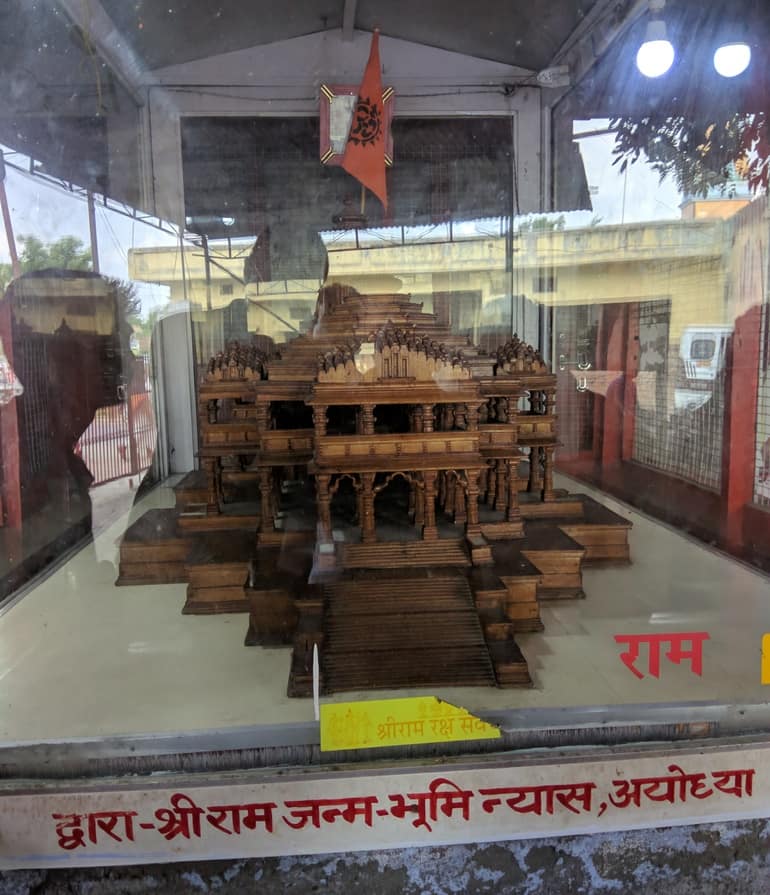
रामजन्म भूमि अयोध्या में सबसे पवित्र जगहों में से एक है। रामजन्म भूमि वह जगह है जहां पर भगवान श्री राम का जन्म हुआ था और एक मंदिर भी बना था। बताया जाता है कि राम मंदिर को मुग़ल शासक बाबर के आदेशों पर नष्ट कर दिया गया था और इसके बाद यहां पर एक मस्जिद का निर्माण करवाया गया है, जिसका विवाद आज तक चल रहा है।
1.2 अयोध्या पर्यटन में प्रमुख मंदिर हनुमान गढ़ी – Ayodhya Paryatan Ke Pramkh Mandir Hanuman Garhi In Hindi

हनुमान गढ़ी अयोध्या के प्रमुख धार्मिक स्थलों में से एक है। हनुमान गढ़ी में हनुमान को समर्पित एक मंदिर है, जिसका अपना एक अलग धार्मिक महत्व है। यह मंदिर वाली जगह पहले अवध के नवाब की थी, जिसने इसे मंदिर के निर्माण के लिए दान दिया था। यह मंदिर एक पहाड़ी की चोटी पर स्थित है जिसे 10 वीं शताब्दी में बनवाया था। मंदिर तक पहुंचने के लिए यात्रियों को 76 सीढ़ी से होकर जाना होता है।
मंदिर में स्थित हनुमान जी की मूर्ति भक्तों का स्वागत करती है। पहाड़ी की चोटी आसपास के पहाड़ियों का बेहद शानदार दृश्य नजर आता है। हिंदू धर्म के लोग बड़ी संख्या में इस मंदिर की यात्रा करने के लिए आते हैं और हनुमान जी के दर्शन करने के साथ ही अपने पापों से मुक्ति के लिए भी प्रार्थना करते हैं। हनुमान गढ़ी के बारे में यह भी मान्यता है कि यहां आने वाले जो भी भक्त सच्चे दिल से मनोकामना करते हैं, उनकी इच्छाओं को भगवान अवश्य पूरा करते हैं।
1.3 अयोध्या के दर्शनीय स्थल त्रेता के ठाकुर – Ayodhya Ke Darshaniya Sthal Treta Ke Thakur In Hindi

त्रेता के ठाकुर अयोध्या में सरयू नदी के तट पर स्थित एक प्राचीन मंदिर है। ऐसा माना जाता है कि इस मंदिर में भगवान राम की मूर्तियों को रखा गया है जो प्राचीन समय में काले रेत के पत्थरों से उकेरी गई थीं। इस मंदिर के बारे में यह भी कहा जाता है कि यह वही जगह है जहां पर श्री राम ने अश्वमेध यज्ञ किया था। अगर आप अयोध्या की यात्रा करने के लिए जा रहे हैं तो आपको इस पवित्र मंदिर के दर्शन के लिए जरुर जाना चाहिए।
1.4 अयोध्या टूरिज्म में घूमने लायक जगह कनक भवन – Ayodhya Tourism Me Ghumne Layak Jagah Kanak Bhawan In Hindi
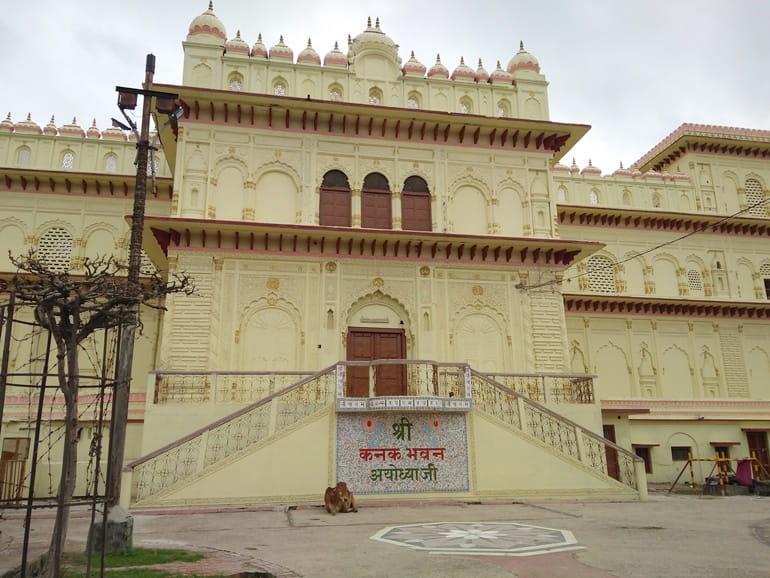
कनक भवन अयोध्या का प्रमुख दर्शनीय स्थल है, जहां पहले एक अन्य मंदिर था। जिसके बारे कहा जाता है कि इस मंदिर को भगवान राम की सौतेली माँ कैकेयी ने विवाह के बाद सीता को दिया था। बता दें कि बाद में इस मंदिर का परमारा वंश के राजा विक्रमादित्य पुननिर्माण किया गया था जिसे 1891 में फिर से बनाया गया। कनक भवन अयोध्या में सबसे आकर्षक स्थानों में से एक है जहाँ की अद्भुत वास्तुकला हर किसी को अपनी तरफ आकर्षित करती है।
और पढ़े: कानपुर के आसपास घूमने लायक 10 खुबसूरत जगहों की जानकारी
1.5 अयोध्या के आकर्षण स्थल मोती महल – Ayodhya Ke Aakarshan Sthal Moti Mahal In Hindi

मोती महल फैजाबाद में अयोध्या शहर से कुछ किलोमीटर की दूरी पर स्थित एक बेहद आकर्षक संरचना है जिसे लोकप्रिय रूप से ‘पर्ल पैलेस’ के रूप में जाना जाता है। इस महल का निर्माण 1743 ई में किया गया था जो नवाब शुजा-उद-दौला की पत्नी रानी बेगम उन्मतुजोहरा बानू का घर था। मोती महल मुगल वास्तुकला में एक बेहतरीन नमूना है और इसे देखने के लिए भारी संख्या में पर्यटक आते हैं। अगर आप अयोध्या के पास घूमने की किसी अच्छी जगह की तलाश में हैं, तो आपको मोती महल देखने के लिए जरुर जाना चाहिए।
1.6 अयोध्या में घूमने लायक जगह गुलाब बारी – Ayodhya Me Ghumne Layak Jagah Gulab Bari In Hindi

गुलाब बारी एक स्मारक है जो अयोध्या के पास फैजाबाद में स्थित है और नवाब शुजा-उद-दौला का मकबरा है। यह मकबरा चारों तरफ से गुलाब के बाग़ से घिरा हुआ है जिसकी वजह से इस जगह का नाम गुलाब बारी पड़ा है। आपको बता दें कि इस जगह पर पानी के फव्वारे से स्थित हैं जो जगह को सुशोभित करते हैं। यह मकबरा वास्तुकला हिंदू और मुगल शैली बीच एक क्रॉस है जिसे नवाबी शैली के रूप में वर्णित किया जाता है। अगर आप अयोध्या घूमने के लिए आ रहें हैं तो गुलाब बारी की सैर करना आपके लिए बेहद यादगार साबित हो सकता है।
1.7 अयोध्या में देखने लायक जगह बहू बेगम की समाधि – Mausoleum Of Bahu Begum Ayodhya Me Dekhne Layak Jagha In Hindi

बहू बेगम का मकबरा अयोध्या के पवित्र शहर में स्थित एक और महत्वपूर्ण ऐतिहासिक स्मारक है। बता दें कि इस मकबरे का निर्माण 1816 में शुजा-उद-दौला की पत्नी बहू बेगम के लिए बनाया गया था। यह मकबरा हरे भरे बगीचे के साथ सफेद संगमरमर में बनाया गया है, जिसे देखने के आपको अवश्य जाना चाहिए।
1.8 अयोध्या के मशहूर दर्शनीय स्थल सीता की रसोई मंदिर – Ayodhya Ke Famous Tourist Place Sita Ki Rasoi In Hindi
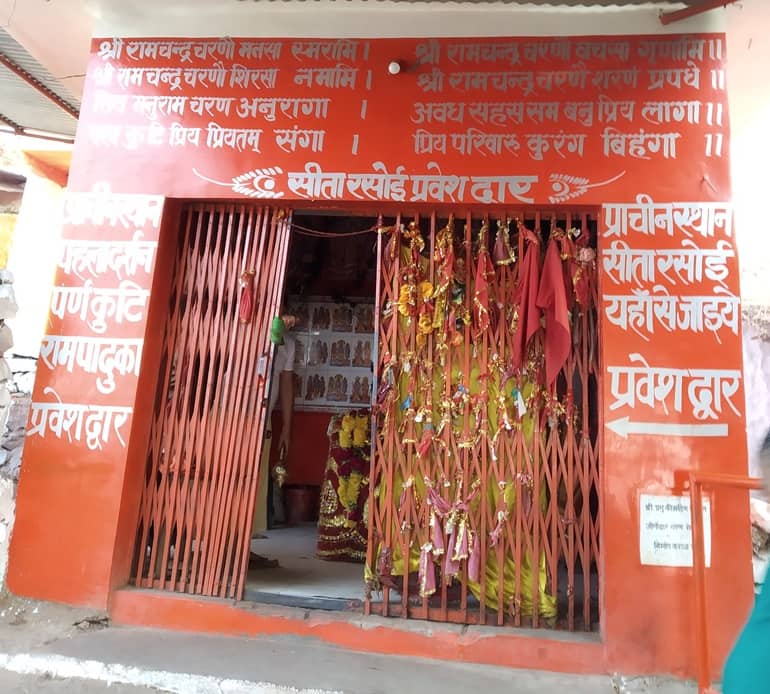
सीता की रसोई अयोध्या के राजकोट में राम जनमस्थान के उत्तर-पश्चिमी छोर पर स्थित है जो यहां की एक देखने लायक जगह है। यह मंदिर के कोने में स्थित प्राचीन रसोई का के मॉडल है जिसमें नकली बर्तन, रोलिंग प्लेट और रोलिंग पिन है। मंदिर परिसर के दूसरे छोर पर चारों भाई राम, लक्ष्मण, भरत और शत्रुघ्न और उनकी पत्नी सीता, उर्मिला, मांडवी और श्रुतकीर्ति की मूर्तियाँ भी हैं। आपको बता दें कि यह सभी मूर्तियां बहुत अच्छी तरह से कपड़े और आभूषण से सजी हुई हैं। अगर आप अयोध्या की यात्रा के लिए जा रहें हैं तो सीता की रसोई को देखना न भूलें।
और पढ़े: प्रयागराज (इलाहाबाद) घूमने के प्रमुख स्थान
1.9 अयोध्या के प्रसिद्ध मंदिर नागेश्वरनाथ मंदिर – Ayodhya Ke Prasidh Mandir Nageshwarnath Temple In Hindi
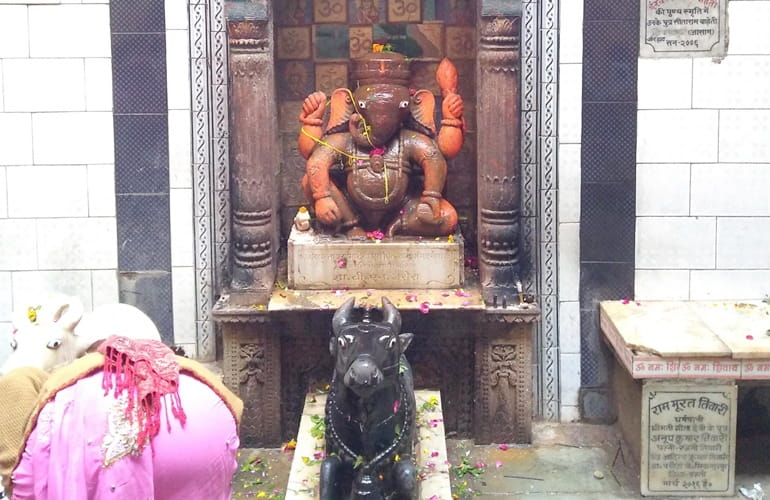
नागेश्वरनाथ अयोध्या का एक प्रमुख मंदिर है जिसे देखने के लिए आपको अवश्य जाना चाहिए। एक पौराणिक कथा की माने तो इस मंदिर को भगवान राम के पुत्र कुश द्वारा बनाया गया था। मंदिर की संरचना अर्ध-दिव्य नागों को भगवान शिव की पूजा करते हुए दिखाती है।
1.10 अयोध्या में घूमने की ऐतिहासिक स्थान तुलसी स्मारक भवन संग्रहालय – Ayodhya Ke Aetihasik Sthal Tulsi Smarak Bhawan Museum In Hindi

तुलसी स्मारक भवन 16 वीं सदी के संत कवि- गोस्वामी तुलसीदास की स्मृति में स्थापित किया गया है जिसका निर्माण 1969 में, उत्तर प्रदेश के तत्कालीन राज्यपाल – श्री विश्वनाथ दास द्वारा करवाया गया था। यह स्मारक अयोध्या में राजगंज चौराहे पर राष्ट्रीय राजमार्ग के पास स्थित है। इस स्मारक में विशाल पुस्तकालय भी है जो समृद्ध साहित्य का भंडार है। इसके अलावा यहां एक अनुसंधान केंद्र भी है, जिसे ‘अयोध्या शोध संस्थान’ कहा जाता है। इस अनुसंधान केंद्र का इस्तेमाल अयोध्या की साहित्यिक, सांस्कृतिक और आध्यात्मिक जानकारी का अध्ययन करने और जोड़ने के लिए किया जाता है। 1988 में यहां एक संग्रहालय भी जोड़ा गया था जिसको राम कथा संग्रहालय कहा जा है जहां श्री राम के जीवन और समय से संबंधित तथ्यों, आंकड़ों और प्राचीन वस्तुओं का संग्रह है।
बता दें कि स्मारक परिसर के भीतर सांस्कृतिक केंद्र में हर दिन शाम 6 बजे से 9 बजे के बीच रामलीला का प्रदर्शन होता है, जो पर्यटकों को बेहद आकर्षित करता है। यहां पर नियमित रूप से प्रार्थना, भक्ति गीत और उपदेश के साथ ही श्रावण मास के प्रत्येक 7 वें दिन तुलसी जयंती का आयोजन बड़ी ही धूम धाम से किया जाता है।
1.11 अयोध्या के फेमस पर्यटन स्थल दशरथ भवन – Dashrath Bhavan Ayodhya Ke Paryatan Sthal In Hindi

दशरथ भवन अयोध्या के फैजाबाद के केंद्र में स्थित है जो राजा दशरथ का मूल निवास स्थान है। बता दें कि दशरथ अयोध्या के शासक और भगवान श्री राम के पिता थे। बादी जग के नाम से लोकप्रिय दशरथ महल में राजा राम के शानदार मंदिर हैं। अगर आप इस महल को देखने के लिए जा रहें हैं तो इसकी सुंदरता को देखकर सच में हैरान रह जायेंगे।
1.12 अयोध्या के तीर्थ स्थल गुप्तार घाट – Ayodhya Ke Tirth Sthal Guptar Ghat In Hindi

गुप्तार घाट अयोध्या के पास फैजाबाद में सरयू नदी के तट पर स्थित हिंदू धर्म का एक पवित्र और पूजनीय स्थल है। इस जगह के बारे में माना जाता है कि यहां पर भगवान श्री राम ने ध्यान किया था और इस नदी के जल में समाधि ली थी। जिसके बाद उन्होंने ‘वैकुंठ’ प्राप्त किया और भगवान विष्णु के रूप में अपने स्वर्गीय निवास के लिए रवाना हो गए। तभी से गुप्तार घाट को एक तीर्थ स्थल के रूप में जाना जाता है।
इस सुंदर घाट में नदियों की ओर जाने वाली सुंदर सीढियां बनी हुई हैं। ऐसी मान्यता है कि जो भी यहां पर नदी में डुबकी लगाता है उसे पापों और परेशानियों से मुक्ति मिल जाती है। गुप्तार घाट पर कई आकर्षक मंदिर बने हुए हैं जिनमें राम मंदिर, चक्रहारी मंदिर और नरसिंह मंदिर सबसे ज्यादा आकर्षक और सुंदर हैं। बता दें कि पवित्र मंत्रों की गूंज के साथ गुप्तार घाट साल भर भक्तों से भरा हुआ रहता है।
और पढ़े: बनारस के घाटों के बारे में जानकारी
2. अयोध्या घूमने जाने का सबसे अच्छा समय – Best Time To Visit Ayodhya Tourism In Hindi

अगर आप भगवान राम के जन्म स्थान अयोध्या घूमने जाने की योजना बना रहें हैं तो बता दें कि वैसे तो यहां पूरे साल मौसम बहुत सुहावना रहता है। लेकिन यहां की यात्रा का सबसे अच्छा समय अक्टूबर से दिसंबर के बीच माना गया है, क्योंकि इस समय मौसम काफी ठंडा होता है और ज्यादातर उत्सव भी इन्ही महीनों में पड़ते हैं।
और पढ़े: लखनऊ के दर्शनीय स्थल और घूमने की 20 जगह
3. अयोध्या कैसे पंहुचा जाये – How To Reach Ayodhya In Hindi
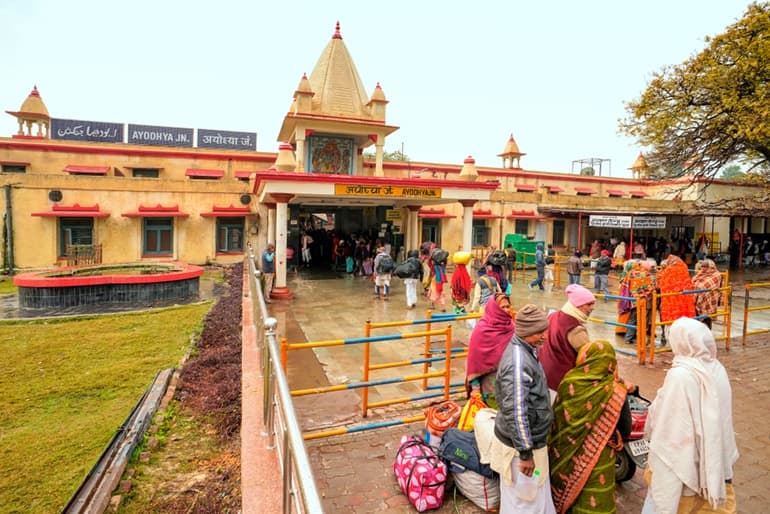
अगर आप अयोध्या जाने की योजना बना रहें हैं तो बता दें कि अयोध्या सीधे मार्ग से देश के प्रमुख शहरों से काफी कम जुड़ा है। लेकिन आप अगर उत्तर प्रदेश में हैं तो आसानी से अयोध्या की यात्रा कर सकते हैं। अयोध्या में अपना कोई हवाई अड्डा नहीं है। लेकिन, यहां पर रेलवे स्टेशन उपलब्ध है। उत्तर प्रदेश के अन्य प्रमुख शहरों से अयोध्या के लिए बसें भी आसानी से उपलब्ध हैं।
3.1 फ्लाइट से अयोध्या कैसे पहुंचे – How To Reach Ayodhya By Flight In Hindi

अगर आप अयोध्या की यात्रा हवाई मार्ग द्वारा करना चाहते हैं तो बता दें कि यहां का निकटतम हवाई अड्डा फैजाबाद हवाई अड्डा है, जो 8 किमी की दूरी पर है। इसके अलावा विकल्प के रूप में 130 किमी की दूरी प्रमुख हवाई अड्डा लखनऊ है। लखनऊ हवाई अड्डा भारत के अधिकांश प्रमुख शहरों से अच्छी तरह से जुड़ा हुआ है। आप लखनऊ हवाई अड्डे से अयोध्या पहुंचने के लिए कैब या टैक्सी किराये पर ले सकते हैं जो आपसे लगभग 1800 से 2000 रूपये तक चार्ज करेगी।
3.2 कैसे पहुंचे अयोध्या सड़क मार्ग से – How To Reach Ayodhya By Road In Hindi

अगर आप सड़क मार्ग से अयोध्या की यात्रा करने के लिए जा रहें हैं तो बता दें कि राज्य में अयोध्या के लिए नियमित रूप से सरकारी और निजी बसें चलती हैं। उत्तर प्रदेश के अन्य स्थलों और अयोध्या के बीच चलने वाली बसें इसे राज्य के अन्य प्रमुख शहरों से भी जोडती हैं।
3.3 ट्रेन से अयोध्या कैसे जाये – How To Reach Ayodhya By Train In Hindi

ट्रेन से अयोध्या की यात्रा करना काफी सुविधाजनक है क्योंकि अयोध्या पूरे उत्तर भारत में नजदीकी रेलवे स्टेशनों और प्रमुख स्टेशनों से जुड़ा हुआ है। जिसकी वजह से ट्रेन द्वारा यहां की यात्रा काफी आसानी हो जाती है।
3.4 अयोध्या में स्थानीय परिवहन – Local Transport In Ayodhya In Hindi

कोई भी पर्यटक अयोध्या में घूमने के लिए या पर्यटन स्थलों की यात्रा के लिए टैक्सी, रिक्शा और बस की मदद ले सकता है।
और पढ़े: सारनाथ का इतिहास और यहां के 5 प्रमुख दर्शनीय स्थल
इस लेख में आपने अयोध्या के प्रमुख मंदिर और पर्यटक स्थलों को जाना है आपको हमारा ये आर्टिकल केसा लगा हमे कमेंट्स में जरूर बतायें।
इसी तरह की अन्य जानकारी हिन्दी में पढ़ने के लिए हमारे एंड्रॉएड ऐप को डाउनलोड करने के लिए आप यहां क्लिक करें। और आप हमें फ़ेसबुक और ट्विटर पर भी फ़ॉलो कर सकते हैं।
4. अयोध्या का नक्शा – Ayodhya Map
5. अयोध्या की फोटो गैलरी – Ayodhya Images
View this post on Instagram Gulab bari ., Nawab sujjaudaulla tomb ❤️ #monument #monuments #historicalmonument #architecture #travel #photography #picoftheday #architectural #art #photooftheday #history #tourism #topparisphoto #culture #traveling #canon #travelgram #heritage #instagood #architecturephotography #monument #monuments #historicalmonument A post shared by Shubham Gupta™ ? Verified (@shubham_gupta_eddie) on Sep 24, 2019 at 5:24am PDT
View this post on Instagram ऊं नागेश्वरनाथाय नमः जय शिव ?? A post shared by shivam (@shivam15sst) on Jan 6, 2019 at 9:45pm PST
View this post on Instagram #kanakbhawan #Ayodhya A post shared by Deepakmishra (@realdeepakmishra05) on Oct 8, 2019 at 7:02am PDT
- वाराणसी के 10 प्रमुख मंदिर
- वृंदावन और मथुरा की होली क्यों है इतनी खास
- बनारस घूमने की जानकारी और 12 दर्शनीय स्थल
- मथुरा के 10 दर्शनीय स्थल और घूमने की जानकारी
- इस्कॉन मंदिर वृंदावन की जानकारी
- आगरा में दर्शनीय स्थल

Leave a Comment Cancel reply
Upcoming Dissertation Defense – 6/20

News from the School

The power of storytelling in public health

New center to tackle health disparities affecting LGBTQ community

Alcohol use disorder among reproductive-age women—and barriers to treatment

Prosthetics nonprofit wants to hear from its patients
Post comment
or continue as guest

- Bahasa Indonesia
- Eastern Europe
- Moscow Oblast
Elektrostal
Elektrostal Localisation : Country Russia , Oblast Moscow Oblast . Available Information : Geographical coordinates , Population, Altitude, Area, Weather and Hotel . Nearby cities and villages : Noginsk , Pavlovsky Posad and Staraya Kupavna .
Information
Find all the information of Elektrostal or click on the section of your choice in the left menu.
- Update data
Elektrostal Demography
Information on the people and the population of Elektrostal.
Elektrostal Geography
Geographic Information regarding City of Elektrostal .
Elektrostal Distance
Distance (in kilometers) between Elektrostal and the biggest cities of Russia.
Elektrostal Map
Locate simply the city of Elektrostal through the card, map and satellite image of the city.
Elektrostal Nearby cities and villages
Elektrostal weather.
Weather forecast for the next coming days and current time of Elektrostal.
Elektrostal Sunrise and sunset
Find below the times of sunrise and sunset calculated 7 days to Elektrostal.
Elektrostal Hotel
Our team has selected for you a list of hotel in Elektrostal classified by value for money. Book your hotel room at the best price.
Elektrostal Nearby
Below is a list of activities and point of interest in Elektrostal and its surroundings.
Elektrostal Page

- Information /Russian-Federation--Moscow-Oblast--Elektrostal#info
- Demography /Russian-Federation--Moscow-Oblast--Elektrostal#demo
- Geography /Russian-Federation--Moscow-Oblast--Elektrostal#geo
- Distance /Russian-Federation--Moscow-Oblast--Elektrostal#dist1
- Map /Russian-Federation--Moscow-Oblast--Elektrostal#map
- Nearby cities and villages /Russian-Federation--Moscow-Oblast--Elektrostal#dist2
- Weather /Russian-Federation--Moscow-Oblast--Elektrostal#weather
- Sunrise and sunset /Russian-Federation--Moscow-Oblast--Elektrostal#sun
- Hotel /Russian-Federation--Moscow-Oblast--Elektrostal#hotel
- Nearby /Russian-Federation--Moscow-Oblast--Elektrostal#around
- Page /Russian-Federation--Moscow-Oblast--Elektrostal#page
- Terms of Use
- Copyright © 2024 DB-City - All rights reserved
- Change Ad Consent Do not sell my data

COMMENTS
Home-Based Care for Young Child Programme (HBYC) was launched in 2018 as part of National Health Mission and POSHAN Abhiyan for promotion of health and nutrition of young children (3-15 months), for reducing child morbidity and mortality and for promotion of growth and Early Childhood Development. Under HBYC, ASHA provides incentivized five ...
1.11 दिल्ली में घूमने वाली जगह वेस्ट टू वंडर पार्क - Waste To Wonder Park Delhi Attractions In Hindi. Image Credit: Naveen Sharma. दिल्ली के आकर्षण के अतिरिक्त, वेस्ट टू वंडर पार्क में ...
Early childhood home visiting is a service delivery strategy that matches expectant parents and caregivers of young children with a designated support person—typically a trained nurse, social worker, or early childhood specialist—who guides them through the early stages of raising a family. Services are voluntary, may include caregiver ...
MIECHV-Supported Home Visiting In Your State. In FY2019, MIECHV-supported home visiting programs provided over 1,000,000 home visits to over 154,000 at-risk children and families in every U.S. state, DC, and five territories. Click a state to view a fact sheet explaining how the MIECHV program works to improve family stability, child health and ...
Boost online engagement and attract buyers from all over the world. 80% of buyers go inside 3D models when it's available, with visits lasting an average of 6 minutes! Put buyers inside your listings any time, anywhere - a 24/7 open house! One of our technicians will scan the entire property with 360° cameras and render a full model within 24 ...
Steps of home visiting Home visit refers to meeting the health needs of people at doorsteps. The steps of home visiting are as follow: 1.Facts findings 2.Data finding 3.Planning action with individual or family 4. Action and health education 5.Follow through 6. Evaluation of services 7.
In this video, we learn how Lydia Places offers Parents as Teachers home visiting as part of a comprehensive approach to serving unhoused families. Home visiting resource center offers data, research, issue briefs, and national yearbook with model input to inform sound policy, practice.
About Us HomeVisit delivers integrated marketing solutions for real estate agents and brokers. With an extended menu of services spanning Fusion Photography, HomeVisit immersive 3D tour and Floor Plan renderings, HD Video Production, Aerial Imaging, Print Materials, Property Websites, Virtual Tours and Direct Mail, we provide the tools you need to market your listings in one place.
14. Approach the visit with self-confidence and caring. The visit begins with a reintroduction and a review of the plan for the day; the nurse must assess what has happened with the family since the last encounter. At this point, the nurse may renegotiate the plan for the visit and implement it.
Parenting isn't always easy. Home Visitors are Partners in Family Resilience. The Nebraska-Maternal, Infant & Early Childhood Home Visiting (N-MIECHV) statew...
Music: Happy Ukulele Musician: Marphologiya
Recently viewed. Yeh Rishta Kya Kehlata Hai: With Hina Khan, Karan Mehra, Ayush Agarwal, Shivangi Joshi. Akshara and Naitik, who were married in an arranged marriage, gradually fall in love and together they face all the problems of their family. Not only this, the stories of his children have also been depicted.
An important aspect of promoting population health has been the tradition of providing services to individual families in their homes. Home visits give a more accurate assessment of the family structure and behavior in the natural environment, while helping to identify barriers and supports for reaching family health goals. Participation of other family members in the household is supported ...
Haridwar Mein Ghumne Ki Jagah In Hindi, यदि आप हरिद्वार की यात्रा पर जाने का प्लान बना रहें हैं तो आपको हरिद्वार में घूमने की जगह कौन-कौन सी है के बारे में जरुर पता होना चाहिए हम ...
The official channel for all Yeh Rishta Kya Kehlata Hai fans by StarPlus!Exclusive digital content, sneak peeks and episodes DAILY!Stay tuned.
Kya h tere pass Follow for more part videos殺 "Visit our profile "Keep following "like comment ☺ "share_____欄 " follow ️ @uniquevideohere Turn on ! Post notification our Hashtags...
A high-level U.S. congressional delegation, including the former House speaker Nancy Pelosi, met with the Dalai Lama at his Indian home on Wednesday, a visit that was condemned in advance by China ...
Best Time to Visit KHATU SHYAM JI Temple IN RAJASTHAN - Winters: The temple is open from 5.30 am to 1.00 pm and from 5.00 pm to 9.00 pm - Summers: The temple is open from 4.30 am to 12.30 pm and from 4.00 pm to 10.00 pm How to reach KHATU SHYAM JI Temple IN RAJASTHAN. Both the road and the train make it simple to reach Khatu Shyam Mandir.
मध्य प्रदेश के प्रमुख पर्यटन स्थलों की जानकारी - Best Places To Visit In Madhya Pradesh Tourism In Hindi पुरी की यात्रा के लिए सलाह और घूमने की जानकारी - Best Tourist Attraction In Puri In Hindi
Visit the post for more. Recent News. June 17, 2024 Upcoming Dissertation Defense - 6/20; June 17, 2024 2024 PQG Conference Earlybird Registration now open!; June 10, 2024 Andrea Foulkes elected as Fellow of American Statistical Association; June 10, 2024 Department History: A long-term view of biostatistics discovery by Stuart G. Baker; June 10, 2024 Student Lightning Talks - 6/13
FGRBI. Early ACCESS special education teacher Peg joins Kiyah and her father, Kris on a home visit. Peg supports Kris to embed opportunities for Kiyah to learn and participate in the family's everyday activities such as getting ready for childcare and taking a walk.
A residential and industrial region in the south-east of Mocsow. It was founded on the spot of two villages: Chagino (what is now the Moscow Oil Refinery) and Ryazantsevo (demolished in 1979). in 1960 the town was incorporated into the City of Moscow as a district. Population - 45,000 people (2002). The district is one of the most polluted residential areas in Moscow, due to the Moscow Oil ...
Elektrostal Geography. Geographic Information regarding City of Elektrostal. Elektrostal Geographical coordinates. Latitude: 55.8, Longitude: 38.45. 55° 48′ 0″ North, 38° 27′ 0″ East. Elektrostal Area. 4,951 hectares. 49.51 km² (19.12 sq mi) Elektrostal Altitude.
Elektrostal is a city in Moscow Oblast, Russia, located 58 kilometers east of Moscow. Elektrostal has about 158,000 residents. Mapcarta, the open map.
economics Presidential libraries preserve history, provide economic boost. Comptroller highlights Texas' presidential treasures . June 2024 | Morgan Hecht and Astrid Alvarado. Home to three presidential libraries, the most of any state, Texas plays a key role in preserving U.S. history through the Lyndon B. Johnson Presidential Library and Museum in Austin, the George H.W. Bush Presidential ...
Elektrostal , lit: Electric and Сталь , lit: Steel) is a city in Moscow Oblast, Russia, located 58 kilometers east of Moscow. Population: 155,196 ; 146,294 ...